![]()
Winter 2013 | Middle East Quarterly, Volume XX: Number 1, pp. 27-35 | by Hannibal Travis
Turkey, Past and Future
It is well known by genocide scholars that in 1939 Adolf Hitler urged his generals to exterminate members of the Polish race.[1] “Who speaks today of the extermination of the Armenians?” Hitler asked, just a week before the September 1, 1939 invasion of Poland.[2] However, while it is generally agreed that Hitler was well aware of the Armenian genocide,[3] some genocide scholars and historians of the Ottoman Empire have questioned whether he actually made the above statement or even intended to exterminate portions of the “Polish race.”[4]
Still, there is evidence that the massacre of the Ottoman Armenians helped persuade the Nazis that national minorities posed a threat to empires dominated by an ethnic group such as the Germans or the Turks. Furthermore, these minorities could be exterminated to the benefit of the perpetrator with little risk. Indeed, it was German officials who had smuggled out of the Ottoman Empire the leaders of the Young Turk regime, culpable for the deaths of over a million Armenians and a million or more other Christian minorities such as the Assyrians and Greeks.[5] Diverse historical evidence suggests that Hitler viewed the Armenians and Poles as analogous; in several ways, his statement about the Armenians was consistent with his other beliefs and writings.

A number of clues point to the possibility that Hitler’s “final solution” was inspired by the Turkish massacre of its Armenian population in 1915. His infamous 1939 question, “Who speaks today of the extermination of the Armenians?” although hotly debated concerning its authenticity, is only one indication leading to that conclusion.
The Assassin’s Leak
The historical context of Hitler’s statement and the manner in which it came to Western attention has long been problematic. On November 24, 1945, The Times of London published an article stating that Hitler referred to the extermination of the Armenians during an address to his commanders-in-chief on August 22, 1939, a statement that was read at a hearing of the Nuremberg trial. Hitler’s speech asserted that the
aim of the war is not to attain certain lines, but consists in the physical destruction of the opponent. Thus, for the time being, I have sent to the East only my “Death’s Head units” with the order to kill without pity or mercy all men, women, and children of Polish race or language. Only in such a way, will we win the vital living space that we need. Who still talks nowadays of the extermination of the Armenians?[6]
The anti-Nazi writer Louis Lochner, a former bureau chief of the Associated Press in Berlin, quoted Hitler’s statement from an original Nazi document before the Nuremberg trials had even convened.[7] Lochner had a variety of sources within the Nazi government and had been interned from December 1941 to May 1942 before being exchanged for German diplomats interned in the United States. After his release, he published What about Germany? containing the quote mentioning the Armenians.[8] The quote was used in the November 1945 The Times article, which cited the ongoing proceedings of the Nuremberg trials.
Two additional copies of the memorandum describing Hitler’s speech were found immediately after the war in the files of the Oberkommando der Wehrmacht (German High Command, OKW), but neither contained the Armenian quote. Nor was either military document signed as would be expected for an official record of a meeting. These incongruities led Nuremberg prosecutors to conclude that there had been two Hitler speeches on August 22 and that the Lochner version containing the quote was a merger of notes from both. As a result of the disparities, objections were made by lawyers for two Nuremberg defendants, Hermann Göring and Erich Raeder, to the authenticity of the OKW versions and to the inclusion of the Lochner document in evidence. The key issue for the defense was not the Armenian quote per se but rather the term “brutal measures,” which they claimed was never used by Hitler although they conceded that he had used “severe” expressions.[9]

Defendants listen to testimony at the Nuremberg trials, November 1945. Although “the extermination of the Armenians” quote was not introduced as evidence at the trials, it was included in the trial record. Pro-Turkish analysts point to this as vindication that the quote is unreliable and that Hitler was not inspired by an Armenian genocide they say never occurred.
Since the prosecution had other records of the meetings, as well as one introduced by defendant Raeder, the Lochner document was included in the trial record but was not introduced as evidence. In the context of the Nuremberg trials, the overriding issue was not the Armenian quote but Hitler’s call for a brutal war of aggression against Poland. But defenders of the Ottoman Empire regard the court’s decision as key: The military versions of Hitler’s speech without the quote are viewed as more reliable, and the Lochner version as suspect or tainted.[10]
The question of Lochner’s source for the document, and hence the quote, has therefore been the crux of intense historical interest. Lochner himself indicated only that he had obtained it from “Mr. Maass” without saying who the original source was at the August 22, 1939 meeting. But subsequent research had shown that the Lochner and The Times versions have a clear chain of transmission.[11] The original source of Hitler’s speech on the Poles and the Armenians and of its transmission to The Times was Wilhelm Canaris,[12] head of the Abwehr, a German military intelligence organization, and a leading figure in the military opposition to Hitler. Canaris became involved with several conspiracies against the dictator, including a July 20, 1944 assassination plot. Another member of the German resistance, Hans Bernd Gisevius, confirmed that Canaris took notes of the speech even though it was “forbidden to do so.”[13]
Canaris’s notes were passed to three men, all of whom were executed before the Nuremberg trials convened and thus could not be questioned: Hans Oster, Ludwig Beck, and Hermann Maass. Historian Kevork Bardakjian concluded that Canaris likely passed the notes to his deputy, Oster, who then transmitted them to Beck, a conservative general and former chief of the General Staff, who had long opposed Nazi influence on the German military and foreign policy. Beck probably instructed Maass, formerly general manager of the Reich Committee of German Youth Associations, to give the document to Lochner due to Beck’s role as a “leader of the German resistance.” Like Canaris, Beck was involved in a number of conspiracies and was executed after the failure of the July 20, 1944 plot to assassinate Hitler, in which he had a leading role.[14] Finally, historian Winfried Baumgart has argued that Canaris’s notes also appear to have been the source of the two unsigned documents in the German high command files.[15]
Gisevius and Oster believed that the invasion of Poland gave them a unique chance to get rid of Hitler and ensure peace with Poland.[16] Canaris’s opposition to Hitler was wide-ranging. An official with British intelligence boasted of having “buil[t] … up” Canaris as a potential assassin of Hitler.[17] In 1944, the Gestapo found documents revealing Canaris to be conspiring with Catholics and the West against Hitler. The admiral was executed in a concentration camp on April 9, 1945, for plotting a coup against Hitler, along with Oster.[18]
Turkish Historians on the “Armenian Quote”
Hitler’s citation of the Armenians in his August 22, 1939 meeting has been an important concern for Turkish historians and pro-Ottoman analysts. Türkkaya Ataöv of Ankara University, with the apparent endorsement of the Turkish government, has contended that the Armenian quote does not appear in Nuremberg documents and is a forgery. He goes further to assert that no Armenian genocide took place, that Armenians had collaborated with the Nazis, and that Turks had welcomed Jews.[19]
Similarly, Princeton University professor Heath Lowry suggested in 1985 that the lack of clear evidence that Hitler’s alleged statement about the Armenians was “authentic” should have put an end to attempts to recognize the Armenian genocide in exhibits of the U.S. Holocaust Memorial Museum, resolutions of the U.S. Congress, or in the curricula on the Holocaust established by state boards of education. The logical outcome, Lowry argued, was that the Armenian genocide was simply a type of “propaganda” and “vilification against the Republic of Turkey.”[20] Finally, Guenter Lewy, professor emeritus of the University of Massachusetts at Amherst, has contended that any attempt to link the anti-Armenian massacres and the Holocaust rests “on a shaky factual foundation.” But Lewy has conceded that the document containing Hitler’s statement about the Armenians might “represent an embellishment of points made in the speech” by Hitler to his generals in August 1939.[21]
In contrast, in a notable 1995 article in Holocaust and Genocide Studies, Roger W. Smith, Eric Markusen, and Robert Lifton argued that Lowry was being professionally irresponsible in claiming that the Armenian genocide was simply a “ludicrous” Armenian claim. In their view, it was the more recent claim that Hitler did not refer to the Armenian genocide that lacked an evidentiary basis.[22] Moreover, they demonstrate that Lowry, like historian Justin McCarthy, had engaged in a pattern of protesting academic characterizations of the Armenian genocide that was welcomed by the Turkish government.[23] According to Inside Higher Education, McCarthy once called the Armenian genocide a “meaningless” idea and served on the board of a grant-making organization in Washington, D.C., the Institute for Turkish Studies, which has ties to the Turkish government. McCarthy argues that the Armenian case is dissimilar to the Holocaust and resembles the U.S. Civil War.[24]
One of Lewy’s preferred sources for Hitler’s speech were the copies from the OKW, used by Nuremberg prosecutors to demonstrate command responsibility for numerous crimes in Poland. Lewy has argued that Hitler’s statement about the Armenians was not “accepted as evidence by the Nuremberg Tribunal,” citing Lowry to this effect.[25] Ankara University’s Ataöv similarly asserted: “Hundreds of thousands of captured Nazi documents were assembled as evidence in the trial of the major Nazi war criminals. One cannot find the oft-repeated Hitler ‘statement’ among these documents.”[26] The idea that the Hitler quote is a forgery and that it does not appear in the Nuremberg trial documents is frequently repeated on websites dedicated to denial of the Armenian genocide.
While the Lochner document was not used at Nuremberg, even Lowry admits that volume VII of the compilation of evidence against the Nazis, entitled Nazi Conspiracy and Aggression, reproduced the statement.[27] That compilation contained in its introduction a description of the document series as the tribunal’s “documentary evidence demonstrating the criminality of the former leaders of the German Reich.”[28] This means that the document was introduced as evidence before the International Military Tribunal at Nuremberg even if it was not used on a specific day of the trials. The Lochner document with the Armenia quote was also included in the 1961 publication of foreign policy documents by the German Foreign Office.[29]
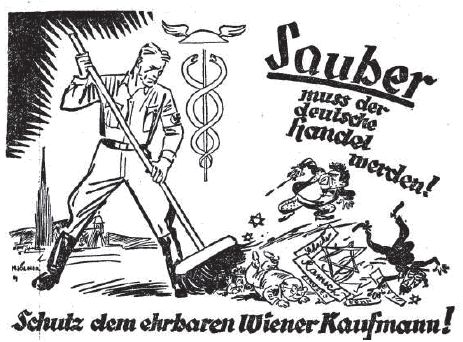
This cartoon reads: “German trade needs to be cleansed — Protect the respectable Viennese shopkeepers.” Both Turks and Nazis made use of the concept of ethnic “cleansing.” According to the German ambassador in Constantinople at the time, the Young Turks implemented a “clean sweep of internal enemies—the indigenous Christians.” Hitler himself used “cleansing” as a euphemism for extermination; Goebbels wrote in his diary that “with respect of the Jewish question, the Führer has decided to make a clean sweep.”
The Armenian Genocide as Nazi Precedent
As part of a larger effort to deny or downplay the Armenian genocide, some historians have claimed that Hitler did not cite the Armenians as an example of the impunity of perpetrators. They have also denied that the Armenian genocide provided the inspiration or any form of precedent for the design and conduct of Nazi aggression and genocide.
One method has been to suggest that the Nazi program of extermination was a late creation. Thus, for example, Lewy suggested that Hitler did not order exterminations in Poland — or mention the extermination of the Armenians — because “by August 1939, Hitler had not yet decided upon the destruction of the Jews.”[30]
This argument is unpersuasive for several reasons. First, as has been shown, there are compelling reasons to believe that Hitler’s statements about extermination in 1939 indeed cited the Armenians and were aimed at the Poles. Hitler’s intentions toward the Jews had been spelled out across many statements, including in the notorious January 1939 speech in which Hitler “prophesied” that another world war would result in the “annihilation of the Jewish race in Europe.” Second, Hitler had repeatedly engaged in virulent anti-Polish and anti-Slavic rhetoric prior to August 1939.[31] Third, Hitler’s decision to destroy Poland as a nation, while allowing some Poles to survive, was entirely consistent with his political philosophy that nations played out a chaotic struggle for life in an unforgiving world, as shown by history. Finally, there was the tacit acquiescence of the major powers in the Turkish model of ethnic cleansing and genocide. These may have provided Hitler with reasons to adopt it for Poland and the East.
To what extent was the Armenian genocide understood as a model by Hitler? In a 1931 interview, he told a German newspaper editor that when deciding Germany’s future, one should “[t]hink of the biblical deportations and the massacres of the Middle Ages (Rosenberg refers to them) and remember the extermination of the Armenians.”[32] Hitler and other contemporary European leaders admired Mustafa Kemal Atatürk as a national leader who won for the Turkish people the living space it needed from the Slavs and the British. Speaking in 1925, Hitler “dwelt at length on patriotism and national pride and quoted approvingly the role of Kemal Atatürk of Turkey and the example of Mussolini, who had marched on Rome” a few weeks prior.[33]
The parallels between Hitler and Atatürk were also noted at the time. The influential Foreign Affairs journal published an article in the 1930s stating, “Just as in Italy since 1922, and as in Germany since early in the present year, the conduct of political affairs in Turkey rests today on the personality of a leader. … By means of a clever scheme … the President, while constitutionally without undue influence, becomes the real autocrat.'” It argued that with the end of foreign “influence,” Turkey “had become an almost homogeneous state” in “national and religious” terms, so that its “Christian minorities hardly existed any longer.”[34] In early 1939, the German socialists had also pointed out the similarity between the Nazis and past leaders of Turkey.[35] Three days after the speech reported by Canaris, Hitler wrote to Mussolini that he hoped that the Turks could be persuaded to join Italy, Japan, and Russia in an anti-British coalition.[36] He planned to hand over parts of the southern Soviet Union to Turkey in due time.[37]
The fate of the Armenians was also understood within Nazi ideology. A key influence on Hitler was the Prussian-educated British writer Houston Stewart Chamberlain. His work Foundations of the Nineteenth Century sold 250,000 copies by 1938 and secured his fame in Germany.[38] Volume 1 of this work offered a model for Germany, arguing that Turkey was “the last little corner of Europe in which a whole people lives in undisturbed prosperity and happiness,” and blaming non-German world powers (Britain and France) for encouraging an Armenian rebellion, in response to which “the otherwise humane Moslem rises and destroys the disturber of the peace.”[39]
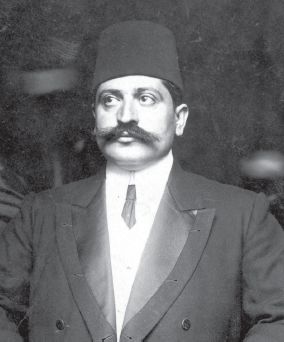
In 1938, Alfred Rosenberg, a leading Nazi theorist, had nothing but praise for Turkish minister of the interior Talat Pasha (seen here), murdered by an Armenian nationalist in Berlin in 1921 for his alleged crimes against the Armenians. Rosenberg justified the Turkish treatment of the Armenians, claiming they had been engaged in espionage against Turkey and comparing them to Germany’s Jews, whom he accused of doing the same.
In 1927, leading Nazi theorist Alfred Rosenberg had published a booklet calling Chamberlain the “apostle and founder of a German future.”[40] In 1938, Rosenberg published a collection of speeches in which he commented that in 1921, after the Turkish minister Talat Pasha was murdered in Berlin by an Armenian, a campaign was waged in the “international press” to release the killer due to the history of struggle between Armenians and Turks.[41] Rosenberg endorsed the Turks’ resistance to Armenian claims for autonomy (“den armenischen Staat im Staat“), comparing the Armenians to the Jews, because he claimed the Armenians engaged in espionage against Turkey as the Jews did against Germany.[42] He “praised Talat Pasha … [and] minimized the [Ottoman Christian] genocide.”[43]
Rosenberg also introduced Max Erwin von Scheubner-Richter to Hitler. Scheubner-Richter had been the German vice-consul in Erzerum and documented the planning and implementation of the murder of Armenians by the Young Turks in the name of Islam and pan-Turkic ideology. Scheubner-Richter’s relationship to Hitler was so close that he was killed standing next to Hitler and Rosenberg during the failed Munich “Beer Hall” putsch of 1923. Hitler then dedicated the first part of Mein Kampf to his “irreplaceable” fallen comrade.[44] Armenian-American historian Vahkan Dadrian has argued that Scheubner-Richter had a “direct” influence on Hitler that may have included introducing him to the example of how the Ottoman Armenians (then called the “Jews of the Orient”) were deported from their villages, worked to death, starved, and frozen to death during exposure to harsh winter conditions.[45] Mike Joseph has called Scheubner-Richter the “personal link from [the Armenian] genocide to Hitler.”[46] Scheubner-Richter’s reports regarding the genocidal solution to the Armenian question foreshadow and may have inspired Hitler’s later ideas and rhetoric regarding the Jews as did his descriptions of Turkish methods, including provocations and allegations of terrorism and revolution. Prior to his death, Scheubner-Richter urged that Germany be “cleansed” of alien peoples by “ruthless” measures.[47]
Other high-ranking Nazis were also well-placed to learn how the Armenian genocide occurred and to inform Hitler. Franz von Papen became Hitler’s vice chancellor after serving as chief of staff of the Fourth Turkish Army during World War I and was responsible for managing German-Austrian and German-Turkish relations under the Nazis. Rudolf Hess, deputy inspector of concentration camps under Himmler, had served in the Ottoman-German forces fighting the Russians during World War I. Hans von Seeckt was chief of the Ottoman General Staff in 1917 and 1918 and “laid the groundwork for the later emergence of the Third Reich’s Wehrmacht” and “embraced Hitler and his ideology.”[48]
The similarity of the genocidal methods employed by the Nazis and the Ottomans is also inescapable. Parallels between Ottoman and Nazi theory and practice include the central place of race in the self-conception of the fascist elites and the notion of relocating ethnic minorities to reservations. Hitler often expressed his belief that race was the dominant independent variable in history and that it had to be dealt with directly by any ethnonationalist leader who wanted to be successful.[49] “When the race is in danger of being oppressed,” he wrote, “the question of legality plays only a secondary role.”[50]
Both the Ottomans and the Nazis also used the concept of ethnic “cleaning” or “cleansing.” While the Young Turks implemented a “clean sweep of internal enemies—the indigenous Christians,” according to the then-German ambassador in Constantinople,[51] the Nazis implemented a “housecleaning of Jews, intelligentsia, clergy, and the nobility.”[52] The official who announced the ethnic cleansing plan for Poland may have been aware of similar policies of the internal security officials of the Ottoman Empire, which resulted in “hundreds of thousands of the Ottoman Empire’s Muslims, Christian Armenians, and Orthodox Greeks [being] expelled or murdered.”[53] Hitler himself used “cleaning” or “cleansing” as a euphemism for extermination[54] and described his rule as being characterized by an “unheard of cleansing process.”[55] On December 12, 1941, Joseph Goebbels wrote in his diary that “with respect of the Jewish question, the Führer has decided to make a clean sweep.”[56] Finally, the impunity with which the Armenians had been slaughtered—the essence of Hitler’s August 22, 1939 remark — was reinforced by the international community’s failure to prevent the massacre of other peoples, including later massacres by the Italians using poison-gas and machine-guns in Ethiopia.[57]
Conclusion
Numerous ideological and political influences led from the Armenian genocide to the rape of Poland and the Holocaust. Chamberlain, Hess, Rosenberg, Seeckt, Scheubner-Richter, and von Papen all likely played a role in prompting Hitler to use Turkey’s example as a model for Poland. Hitler compared the two cases in his 1939 speech, which, like most evidence that the Holocaust took place, was not relied upon in the tribunal’s judgment.[58] Subsequent efforts to discredit the speech by defenders of the Ottoman Empire should not, however, blind us to the manifold connections between the Armenian genocide and that perpetrated by the Nazis.
Hannibal Travis is the author of Genocide in the Middle East: The Ottoman Empire, Iraq and Sudan (Carolina Academic Press, 2010) and “The Assyrian Genocide: A Tale of Oblivion and Denial,” in Rene Lemarchand, ed., Forgotten Genocides: Denial, Oblivion, and Memory (University of Pennsylvania Press, 2011).
![]()
Notes:
[1] Adam Jones, Genocide: A Comprehensive Introduction, 2nd ed. (London: Routledge, 2010), p. 149.
[2] Akten zur deutschen auswärtigen Politik 1918-1945, Federal Republic of Germany, Federal Foreign Office, ser. D, vol. 7, 1961, p. 193, fn. 1; Louis P. Lochner, What about Germany? (London: Hodder and Stoughton, 1943), p. 12.
[3] Jones, Genocide, p. 173.
[4] Heath W. Lowry, “The U.S. Congress and Adolf Hitler on the Armenians,” Political Communication and Persuasion, 3, 1985, pp. 111-39.
[5] Vahakn Dadrian, “The Armenian Genocide in German and Austrian Sources,” in Israel Charny, ed., The Widening Circle of Genocide, vol. 3 (New Brunswick: Transaction, 1994), pp. 122-4.
[6] Nazi Conspiracy and Aggression, vol. 7, U.S. Chief Counsel for the Prosecution of Axis Criminality (Washington, D.C.: Govt. Printing Office, 1946), p. 753.
[7] Lowry, “The U.S. Congress and Adolf Hitler on the Armenians,” pp. 113-4, 121.
[8] Lochner, What About Germany? pp. 11-2.
[9] Kevork B. Bardakjian, Hitler and the Armenian Genocide (Toronto: Zoryan Institute, 1985), pp. 14-5, 18.
[10] Lowry, “The U.S. Congress and Adolf Hitler on the Armenians,” p. 116.
[11] Bardakjian, Hitler and the Armenian Genocide, pp. 20-3; idem, “Hitler’s ‘Armenian Extermination’ Remark, True or False?” The New York Times, July 6, 1985.
[12] Vahakn Dadrian, “The Historical and Legal Interconnections between the Armenian Genocide and the Jewish Holocaust: From Impunity to Retributive Justice,” The Yale Journal of International Law, 23 (1998): 539-40; Allan Bullock, Walter Schellenberg, The Labyrinth: Memoirs of Walter Schellenberg, Hitler’s Chief of Counterintelligence (New York: Harper and Bros., 2000), pp. x-xi, 353, 359-60; Joachim Fest, Plotting Hitler’s Death: The Story of German Resistance, Bruce Little, trans. (New York: Metropolitan Books, Henry Holt, 1997), p. 5.
[13] Bardakjian, Hitler and the Armenian Genocide, pp. 20-1.
[14] Ibid., pp. 20-3; Bardakjian, “Hitler’s ‘Armenian Extermination’ Remark, True or False?”; Helen Fein, “Political Functions of Genocide Comparisons,” in Yehuda Bauer, Alice Eckardt, and Franklin H. Littell, eds., Remembering for the Future: Working Papers and Addenda, vol. 3 (Oxford: Pergamon Press, 1989), p. 2432.
[15] Winfried Baumgart, “Zur Ansprache Hitler’s vor den Führern der Wehrmacht am 22. August 1939. Eine quellenkritische Untersuchung,” Vierteljahrshefte für Zeitgeschichte, Apr. 1968, pp. 120-49.
[16] Fest, Plotting Hitler’s Death, p. 110.
[17] John H. Waller, The Unseen War in Europe: Espionage and Conspiracy in the Second World War (London: I.B. Tauris, 1996), pp. 237, 357.
[18] Bardakjian, Hitler and the Armenian Genocide, p. 22; Michael Mueller and Geoffrey Brooks, Canaris: The Life and Death of Hitler’s Spymaster (Annapolis: Naval Institute Press, 2007), pp. 208, 245-57.
[19] Türkkaya Ataöv, “The ‘Armenian Question’: Conflict, Trauma and Objectivity,” Ministry of Foreign Affairs, Center for Strategic Research, Republic of Turkey, SAM Papers, no. 3 / 97 (1999), accessed Jan. 5, 2012.
[20] Lowry, “The U.S. Congress and Adolf Hitler on the Armenians,” pp. 123-4.
[21] Guenter Lewy, The Armenian Massacres in Ottoman Turkey: A Disputed Genocide (Salt Lake City: University of Utah Press, 2005), p. 265.
[22] Roger W. Smith, Eric Markusen, and Robert Jay Lifton, “Professional Ethics and the Denial of Armenian Genocide,” Holocaust and Genocide Studies, Spring 1995, pp. 9, 12.
[23] Ibid., pp. 9-10.
[24] Scott Jaschik, “Genocide Deniers,” Inside Higher Education, Oct. 16, 2007.
[25] Lewy, The Armenian Massacres in Ottoman Turkey, p. 265; Lowry, “The U.S. Congress and Adolf Hitler on the Armenians,” p. 120.
[26] Ataöv, “The ‘Armenian Question’,” accessed Jan. 5, 2012.
[27] Lowry, “The U.S. Congress and Adolf Hitler on the Armenians,” Appendix II.
[28] Roger W. Barrett and William E. Jackson, “Preface,” in Nazi Conspiracy and Aggression, vol. 1, Nuremberg Commission, Jan. 20, 1946.
[29] Akten zur deutschen auswärtigen Politik, p. 193, fn. 1.
[30] Lewy, The Armenian Massacres in Ottoman Turkey, p. 265.
[31] Richard Veatch, “Minorities and the League of Nations,” in United Nations Library, ed., The League of Nations in Retrospect (Boston-New York: Walter de Gruyter, 1983), p. 380; Otto Tolischus, “German Army Attacks Poland,” in Douglas Brinkley, ed., The New York Times Living History: World War II, 1939-1942: The Axis Assault (New York: Macmillan, 2003), p. 82; Henrik Eberle and Matthias Uhl, eds., The Hitler Book: The Secret Dossier Prepared for Stalin from the Interrogations of Hitler’s Personal Aides (Jackson, Tenn.: Public Affairs, 2006), pp. 47-8; William Shirer, The Rise and Fall of the Third Reich (New York: Simon and Schuster, 1960), pp. 872, 875.
[32] Richard Breiting, Secret Conversations with Hitler: The Two Newly-discovered 1931 Interviews, Édouard Calic, ed. (New York: John Day, 1971), p. 81; Édouard Calic, Unmasked: Two Confidential Interviews with Hitler in 1931, Richard Barry, trans. (London: John Day, 1971), p. 81; Dadrian, “The Historical and Legal Interconnections between the Armenian Genocide and the Jewish Holocaust,” p. 540.
[33] Martyn Housden, Hitler: Study of a Revolutionary (New York: Psychology Press, 2000), p. 47.
[34] Hans Kohn, “Ten Years of the Turkish Republic,” Foreign Affairs, Oct. 1933, pp. 143, 145.
[35] Robert Gellately, Backing Hitler: Consent and Coercion in Nazi Germany (New York: Oxford University Press, 2002), p. 129.
[36] Hitler to Mussolini, Aug. 25, 1939, in Max Domarus, ed., Hitler: Speeches and Proclamations 1932-1945: The Chronicle of a Dictatorship, vol. 3 (London: I.B. Tauris, 1996), p. 1689.
[37] Robert Gellately, Lenin, Stalin, and Hitler: The Age of Social Catastrophe (New York: Random House, 2009), p. 422.
[38] Shirer, The Rise and Fall of the Third Reich, pp. 152, 156.
[39] Houston Stewart Chamberlain, The Foundations of the Nineteenth Century, vol. 1, John Lees, trans. (London: J. Lane, 1911), pp. 6-7.
[40] Fritz Nova, Alfred Rosenberg: Nazi Theorist of the Holocaust (New York: Hippocrene Books, 1986), p. 12.
[41] Alfred Rosenberg, Kampf um die Macht: Aufsätze von 1921-1932, Thilo von Trotha, ed. (Munich: F. Eher nachf., 1943), p. 435.
[42] Ibid., p. 436.
[43] Tessa Hofmann, “An Eye for an Eye: The Assassination of Talaat Pasha on the Hardenbergstrasse in Berlin,” in Huberta von Voss, ed., Portraits of Hope: Armenians in the Contemporary World, Alasdair Lean, trans. (New York: Berghahn Books, 2007), p. 295.
[44] Jay W. Baird, To Die for Germany: Heroes in the Nazi Pantheon (Bloomington: Indiana University Press, 1992), p. 46.
[45] Dadrian, “The Historical and Legal Interconnections between the Armenian Genocide and the Jewish Holocaust,” pp. 534-7.
[46] Mike Joseph, “Max Erwin von Scheubner-Richter: The Personal Link from Genocide to Hitler,” in Hans-Lukas Kieser and Elmar Plozza, eds., Der Völkermord an Den Armeniern, Die Türkei und Europa (Zurich: Chronos, 2006), pp. 147, 198.
[47] Dadrian, “The Historical and Legal Interconnections between the Armenian Genocide and the Jewish Holocaust,” pp. 535-6.
[48] Dadrian, “Documentation of the Armenian Genocide,” p. 107; idem, “The Historical and Legal Interconnections between the Armenian Genocide and the Jewish Holocaust,” pp. 533-6.
[49] Domarus, Hitler: Speeches and Proclamations 1932-1945, vol. 3, pp. 2618, 2748-9, 2593, 2717-8, 2764, 2774, 3130, 3260; Adolf Hitler, My Struggle (London: Hurst and Blackett, 1938), pp. 152-85.
[50] Albert Camus, “State Terrorism and Irrational Terror,” in Roger Griffin and Matthew Feldman, eds., Fascism: Critical Concepts in Political Science (London: Routledge, 2004), p. 16.
[51] German Ambassador in Constantinople, Wangenheim, to the German Imperial Chancellor, Bethmann Hollweg, DE/PA-AA/R14086, DuA Dok. 081 (gk.), June 16, 1915, in Wolfgang and Sigrid Gust, eds., A Documentation of the Armenian Genocide in World War I (n.p., 1995-2012); Richard Hovannisian, “Introduction: History, Politics, Ethics,” in Richard Hovannisian, ed., The Armenian Genocide: History, Politics, Ethics (New York: St. Martin’s Press, 1992), pp. xi-xii.
[52] Shirer, The Rise and Fall of the Third Reich, p. 874.
[53] Robert Gerwarth, Hitler’s Hangman: The Life of Heydrich (New Haven: Yale University Press, 2011), p. 151.
[54] M. Cherif Bassiouni, “From Versailles to Rwanda in Seventy-Five Years: The Need to Establish a Permanent International Criminal Court,” Harvard Human Rights Journal, Spring 1997, p. 21.
[55] Norman Hepburn Baynes, ed., The Speeches of Adolf Hitler, April 1922-August 1939, vol. 1 (New York: H. Fertig, 1969), pp. 1115-6.
[56] Die Zeit (Hamburg), Jan. 9, 1998; Richard Weikart, Hitler’s Ethic: The Nazi Pursuit of Evolutionary Progress (New York: Palgrave Macmillan, 2009), p. 193.
[57] George Baer, Test Case: Italy, Ethiopia, and the League of Nations (Stanford: Hoover Institution Press, 1976), pp. 66, 92-3, 170, 183, 199-214, 274, 281, 290-6; A.J. Barker, The Rape of Ethiopia, 2nd ed. (New York: Ballantine Books, 1971), pp. 106-29; Angelo Del Boca, The Ethiopian War, 1935-1941, P.D. Cummins, trans. (Chicago: University of Chicago Press, 1969), pp. 78-84, 109, 120; John W. Turner, “Mussolini’s Invasion and the Italian Occupation,” in A Country Study: Ethiopia (Washington, D.C.: Library of Congress, 1991), call no. DT373 .E83 1993.
[58] Lewy, The Armenian Massacres in Ottoman Turkey, p. 265.



 RSS
RSS


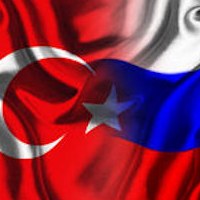
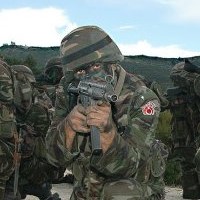

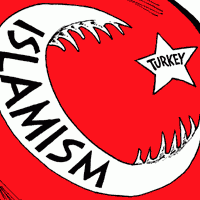




[…] Ensaio (em inglês) – Como o Genocídio Armênio inspirou Hitler […]